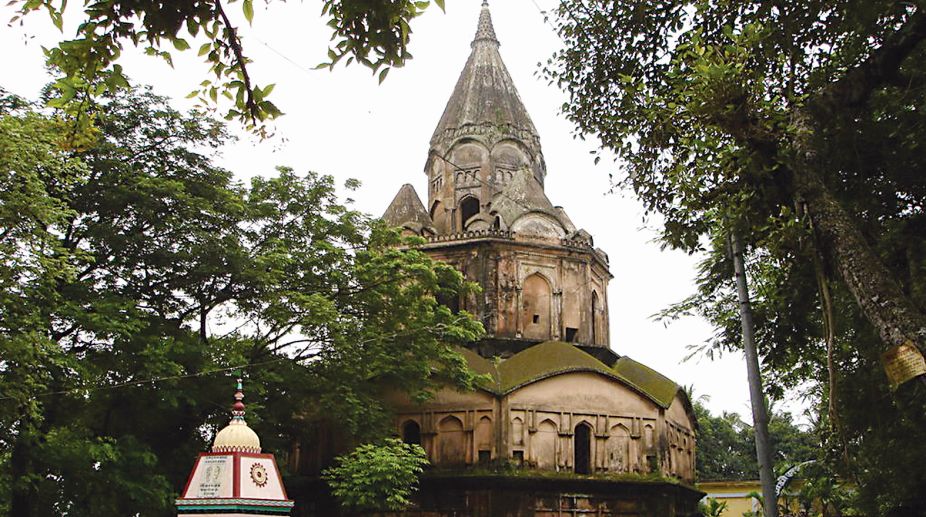The deafening sound of silence
In these times, one must of course eulogize the power of silence.

Jagannath Temple
During British Raj, prosperous Comilla was called the “town of banks and tanks”. The town still has a number of very large man-made water tanks. Most banks, however, are now extinct due to post-partition exodus of Hindu owners and subsequent West Pakistani manipulations. The pedal-rickshaw infested crossing, between the century old building of Pubali Bank and the Town Hall, is still the busy focal point of the town. The bank is still in business and Town Hall active with social and cultural events. Many Bengali cultural stalwarts including Kaji Nazrul Islam, SDBurman were once part of Comilla cultural scene. My friend had invited me to Comilla Club, located within the Town Hall complex. Its lawn tennis courts, opulent teak-paneled card rooms and large international tournament quality billiard rooms spelt the town’s classy heritage.
The main street of the town, lined up with big shops – jewellery, medicine, sweetmeat, clothing etc, gave an impression of a mixed-religion character of the city. Most of these shops were originally owned by the Hindus but with time and tide many changed hands. But, interestingly, brand names of some such institution were so strong, that the new Muslim owners have kept the original Hindu family names in their signboards. Some iconic, Hindu establishments still continue to do roaring business. Some of them like Matri Bhander, which produces distinctive and heavenly tasteful Rasomalai is deservedly world-famous, and inspired many copycats.
While none of the Town’s mosques are considered a tourist spot, its famous Hindu temples are often visited by a number of curious local Muslims tourists other than Hindu pilgrims and tourists. In the centre of the town, the Rajeswari Kali temple is quite active even to this day. The ancient Jagannath temple is a grand ancient edifice that makes its presence felt in an isolated stretch just outside the town. Built by the King of Tripura, and recently adopted by Iskcon, it is one of the very few heritage Hindu religious structures that remained un-vandalised so far. Quite in contrast to the serene majesty of the Jagannath temple is the simple but exuberant double Do-chala (dual roof) architecture of Chandimura temple that draws many pilgrims and tourists. This temple of Goddess Durga is magnificently situated on a hill top at the outskirt of the city.
Advertisement
An isolated eleven-mile long spur of dimpled low hill range known as the Mainamati- Lalmai range runs through the middle of Comilla district from north to south. Most visited site here is Mainamati complex, home of one of the most important Buddhist archaeological sites in the sub-continent is located just beyond the Comilla cantonment area. Dating approximately from 7th to 12th CE, the centre-piece of the sprawling complex is the Shalban Vihara, an ancient Buddhist religious educational centre. It consists of 115 cell-like residential areas for Buddhist religious students, built around a spacious courtyard with a temple in the centre, facing its only gateway complex to the north. Kutila Mura situated on a flattened hillock, about 5 km north of Salban Vihara, three stupas are found side by side representing the Buddhist “Trinity” or three jewels, i.e. the Buddha, Dharma and Sangha. Charpatra Mura is an isolated small oblong shrine situated about 2.5 km. north-west of Kotila Mura stupas. The only approach to the shrine is from the east through a gateway which leads to a spacious hall. Here a number of shrines can be found. The Mainamati Museum houses a good collection of stone and bronze sculptures as well as numerous other artifacts found at these sites.
Later we embarked on a day-trip to Chandpur city, about 60 Km away. While I wanted to explore local attractions on the way like Famous Hazipur Mosque, my parents’ were more interested to visit their ancestral homesteads. During the partition of India, families of both my parents were forced to leave their homes and farmlands, located in nearby villages. It was an emotional scene when they actually reached the spot and saw their sprawling Dasher Bari, encompassing many tinned roofed houses, ponds and gardens. The current occupiers were very cordial in one case, and quite diffident in case of the other.
However, the sadness from the bitter memories, slowly evaporated when tracking the Dakatiya (Gomoti) river we reached the Chandpur Mohana, a truly amazing natural sight. Here, the Gomoti river joins the huge streams of the Padma (Ganges river) and the Jamuna (Brahmaputra river), forming a apparently unlimited expanse of water. It’s a scene immensely beautiful and slightly foreboding at the same time. From Thota, a jutting land extension at the meeting points, we watched the teeming life on the river – large steamers, smaller passenger and fishing boats later ones catching world’s tastiest Hilsa fish.
Back in Comilla, following our parents’ fond memories, we resumed our exploration of many pre-independence-day nationalistic institutions, like Ishwar Pathshala, Victoria College, Abhai Ashram and Ram Ghat.
Unfortunately, due to Hindu exodus and policies of past Pakistani establishments, most have lost their shine. But, good thing is, most of such progressive social and educational institutions them still stand. And, in the similar spirit, globally known BRAC (Bangladesh Rehabilitation Action Committee) was established after Bangladesh’s interdependence and is shining bright today. The level of religious amity and mutual accommodation between the religious communities are believed to be better in Comilla than anywhere else in Bangladesh, a fact that we could feel through our interactions and hospitality of warm hearted Bangladeshis.
Advertisement